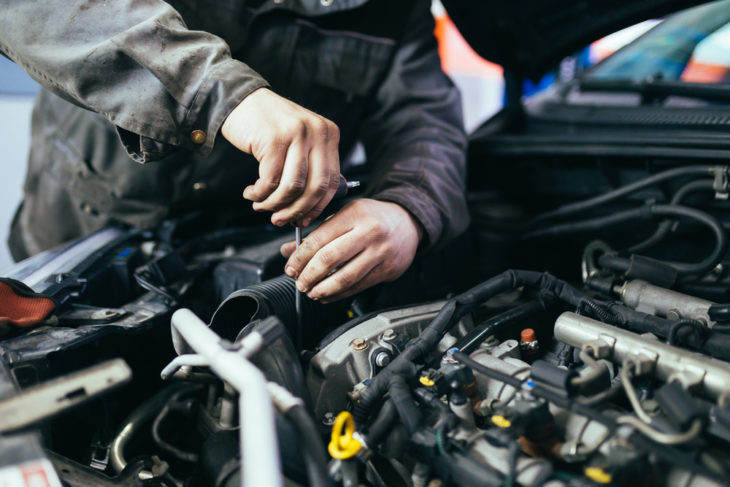Mechanics spend a lot of time repairing, inspecting and maintaining vehicle equipment to keep the cars in good condition and safe for use. With this said, they are often times at risk of asbestos exposure while performing daily responsibilities. The mineral can be found in various car parts such as brakes, clutches, valve rings, hoodliners and several others.
How does a mechanic get exposed to asbestos?
Automotive and aircraft mechanics are still in danger of coming into contact with asbestos. The mineral was added in the composition of various parts because of its heat-resistant qualities, but when these parts start to disintegrate or break apart, the asbestos fibers are released into the air and on the mechanics’ clothes.
The concentration of asbestos in these components varies between 30% and 80% and the number of mechanics exposed to asbestos is estimated at 900,000. The two most common ways to get exposed to asbestos are blowing out brake surfaces and beveling.
When a mechanic puts new brakes onto a car, he has to first remove the old parts. This is when asbestos dust can be released into the air. When inhaled, asbestos fibers get stuck into the lungs lining, leading in time to asbestos-related diseases such as lung cancer, pleural mesothelioma or asbestosis.
Most uses of asbestos were stopped decades ago, but Ford was still using the mineral in the brake linings for the 1993 Crown Victoria. Asbestos is still used in high-end imports such the Land Rover and can also be found in aftermarket parts.
The Seattle Post-Intelligencer led an investigation which showed that 1 in 10 mechanics in the US is at risk of developing asbestos-related cancer. The dust found in garages and shops contained between 2.26% and 63.8% asbestos and the mineral was found in 6 out of 9 examined brake jobs.
What vehicle parts can contain asbestos?
- Hood liners. Millions of vehicles still have automotive hood liners which include asbestos fibers.
- When the brake linings containing asbestos wear down, they release dust which gets trapped in the brake housing. Once this is opened, the asbestos dust is released into the air.
- Some clutch parts can contain asbestos. Once the part starts to wear down, the resulted dust is collected in the clutch compartment. When the clutch cover, disc, wheel or drum is removed, the dust is released.
- Gasket material, valve rings, heat seals and packing. Each of these parts contained asbestos and was used in every single system that had as purpose transporting gases or fluids.
Asbestos was used in these parts to assist with heat transfer and heat resistance, to prevent unnecessary wear and erosion and to increase durability. Among the companies that used asbestos in the past we can mention Ford Motor, General Motors, John Deere International, Borg-Warner Automotive, Bendix Corporation and Raybestos. Some manufacturers stopped using asbestos for their car parts decades ago, but aftermarket products from other countries likely still contain the mineral.
How to prevent asbestos exposure?
According to the U.S. Environmental Protection Agency (EPA) mechanics are required to use respirators and protective suits if 1% or more asbestos dust is present. But still, mechanics should assume that all brake shoes might contain asbestos and take the necessary precautions to prevent exposure.
Also, mechanics should use brake parts that are ready to install instead of those that have to be drilled, cut or ground. With these ready to use parts, mechanics can reduce or even eliminate the amount of asbestos dust entering the air. Before they leave home after work, mechanics should remove the dirty work clothes. This way they will avoid exposing their family members to asbestos particles.
When doing any brake job, the commercial automotive repair shop should apply one of these methods to ensure safe work:
- Use a HEPA or negative-pressure enclosure vacuum system
- Use a wet or low-pressure cleaning system
- Use the wet wipe method to wet all clutch or brake parts
Asbestos-Related Lawsuits
In an ongoing lawsuit, Jenny Bowser, the wife of Gerald Bowser, a former aircraft mechanic, sued Parker-Hannifin Corporation after her husband died of mesothelioma. She blames the company for her husband’s exposure on aircraft brakes that contained asbestos. The brakes were sold by Cleveland Wheel & Brakes and manufactured by a predecessor to Parker-Hannifin Corporation.
Between 1965 and 1967, Gerald Bowser worked at Doan Helicopter in Daytona Beach, Florida on a fleet of three helicopters. Jenny Bowser recalled seeing the unopened Cleveland brake boxes but did not know that working with those parts would expose her husband to asbestos. After this, Gerald worked at the Shelby, N.C., airport between 1967 and 1973. There he had to remove and install asbestos-containing airplane brakes from Goodyear, Cleveland, Goodrich and Bendix.
Browser testified he performed airplane brake jobs when he was a maintenance director at Beaunit Corporation between 1973 and 1976 and at Henry Wurst, Inc between 1976 and 1990. In 2009 he was diagnosed with mesothelioma and he died in 2010. In 2011, Jenny Bowser sued Parker-Hannifin Corporation for manufacturing, distributing and selling asbestos-containing products that caused Gerald Bowser’s mesothelioma.
About the contributor author
Gregory A. Cade is one of the best lawyers at ENVIRONMENTAL LITIGATION GROUP, P.C. He has an experience of more than two decades and has so far represented thousands of claims from injured people. Mr. Cade likes challenges and believes that every case has a solution no matter how demanding it might be.









